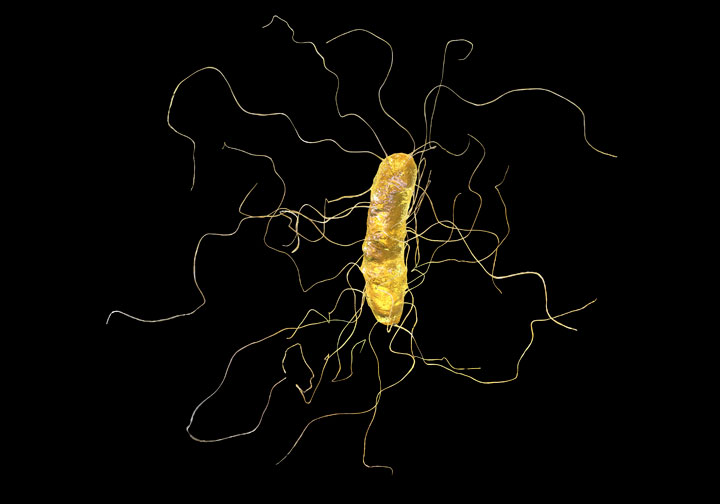Sometimes scientists look for new species in the jungle or deep in the oceans. Other times they look in hospital rooms.

Researchers reported this week in Nature Genetics that a subset of Clostridium difficile bacteria is on the verge of becoming a new species.
And they found it in hospitals, where it represents about 69 per cent of all C. difficile cases in the U.S., and 100 per cent in China, according to the paper.
The subset of C. difficile, known as “Clade A,” lives there for a reason, researchers say. This bacteria is perfectly adapted for life in hospital, with good resistance to common cleaners like hydrogen peroxide.
It also has a sweet tooth. (Or would, if it had teeth.) It seems to react very happily when it’s fed sugar — which we eat a lot of — reproducing more quickly and producing more spores when it gets the sweet stuff, at least in mice.
“Our large-scale genetic analysis allowed us to discover that C. difficile is currently forming a new species with one group specialised to spread in hospital environments,” said Dr. Nitin Kumar, a senior bioinformatician and co-author of the paper.
Another type of C. difficile, Clade B, is different enough from Clade A to suggest that the two types are drifting apart and may someday be two different species, the paper said.
“I think it’s another piece of the puzzle to shed light on why C. difficile behaves the way that it does in health care environments,” said Dr. Kevin Katz, medical director of infection prevention and control at North York General Hospital, and an associate professor in the University of Toronto’s faculty of medicine.
C. difficile infection
Health care providers are very interested in C. difficile. It’s the biggest cause of infectious diarrhea in Canadian hospitals and long-term care homes, according to the Public Health Agency of Canada.
“There’s no question when you look at the ranking. It’s probably number two or three in terms of preventable health care complications,” Katz said.
Infection with C. difficile leads to frequent trips to the bathroom, stomach pain, fever and nausea, according to the Centers for Disease Control.
Generally, two things have to happen for people to be infected with C. difficile, Katz said: they need to get colonized with the bacteria, and ironically, they need to be taking antibiotics.
WATCH: What is a fecal transplant?
.jpg?w=1040&quality=70&strip=all)
Many people carry C. difficile, but that’s fine as long as all the other bacteria in their bodies keeps the C. difficile in check, he said. Taking antibiotics for an infection upsets this balance, because C. difficile is stubbornly resistant to many antibiotics.
So, the drugs might kill off other the bacteria, but not the C. difficile — or an antibiotic might be targeted at a different bacteria, killing it off but not affecting others. That leaves an empty field for C. difficile to reproduce in, and that’s when problems develop.
Recently, Canadian hospitals have dramatically cut the rates of C. difficile infection — 36 per cent over four years — by addressing these two things.
First, they’ve gotten better at disinfecting hospital rooms and isolating C. difficile patients, to ensure that others aren’t infected with the bacteria in the first place.
And second, doctors prescribe fewer antibiotics — though still too many, Katz said.
Evolution at work
The Nature Genetics paper delves into the C. difficile genome, looking at thousands of years of bacterial evolution.
The C. difficile Clade A subtype likely began to develop some of its characteristics, like stronger cleaning solution-resistant spores and a love of sugar, some 76,000 years ago, Kumar said.
But it really took off in the Renaissance, the researchers found, just a century or so before health care started to develop some of its modern characteristics.
“This particular bacteria was primed to take advantage of modern health care practices and human diets, before hospitals even existed,” Kumar said.
Now, he said, “they’re mostly in hospitals.”
WATCH: A bacteria-sniffing dog saving lives at B.C. hospitals

While it takes a very long time to create a new species, C. difficile bacteria continue to evolve, developing resistances to common antibiotics, for example.
For bacteria to be considered its own species, its members have to share more than 95 per cent of their genetic code, Kumar said. Clade A is right on that line, he said. He doesn’t know how long it will take to fully become a new species but believes it’s on the way.
He also thinks that knowing that this most common type of C. difficile, Clade A, loves sugar, could help hospitals find a more appropriate, less sugar-heavy diet for patients recovering from surgery for example.
Katz thinks it’s a little too early in the research for hospitals to take specific measures like changing the menu, but he does think this paper poses some interesting questions that could someday help inform hospital practice.
“It’s very interesting foundational work. I think additional work needs to be done to see where the rubber hits the road,” he said. He hopes more research is done to further investigate the paper’s findings.
“The more we know about C. difficile and why it behaves the way it does, the better that we’ll be able to manage it.”


Comments